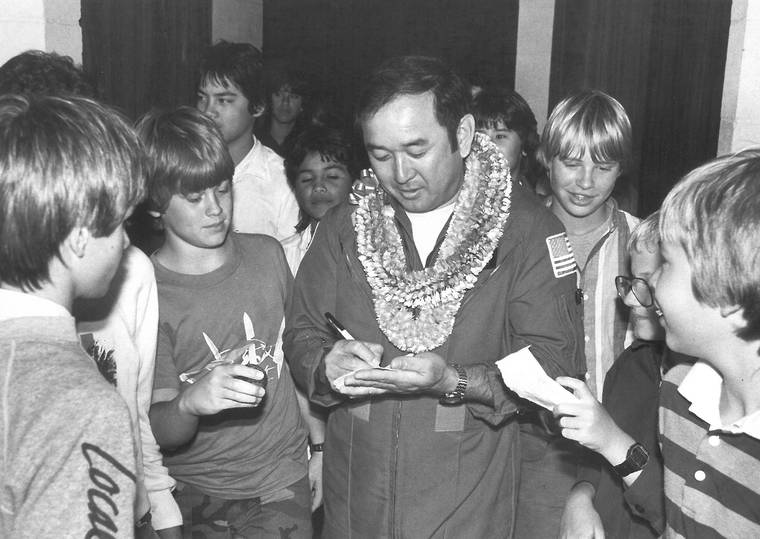Kona’s own homegrown hero, the late astronaut Ellison Onizuka, is being honored by having a spacecraft named after him.
The S.S. Ellison Onizuka is a NG-16 Cargo Delivery Mission shuttle serving the International Space Station.
Northrop Grumman Corporation, an American multinational aerospace and defense technology company announced Tuesday it was proud to name the NG-16 Cygnus spacecraft after Onizuka. It is the company’s tradition to name each Cygnus spacecraft after an individual who has played a pivotal role in human spaceflight. Onizuka was selected in honor of his status as the first Asian American astronaut to reach space.
Onizuka, a Konawaena High School graduate, was born in Kealakekua on June 24, 1946. He received a bachelor’s and master’s degree in aerospace engineering from the University of Colorado. While studying at Colorado, Onizuka was a member of the United States Air Force ROTC.
After completing his education, Onizuka continued his Air Force career as a flight test engineer and test pilot at McClellan Air Force Base in California. He later trained at the Flight Test Center at Edwards Air Force Base, and later led engineering support for the training resources division. Onizuka logged more than 1,700 flight hours during his time at the flight school.
His NASA career began in January 1978, when he was selected for the astronaut program. Completing his training in August 1979, Onizuka went on to work on orbiter test and checkout teams, as well as launch support crews at the Kennedy Space Center in Florida. He later worked on the software test and checkout crew at the Shuttle Avionics and Integration Laboratory, and held supporting roles as an astronaut crew equipment/ orbiter crew equipment coordinator. He also worked on systems and payload development.
Onizuka’s first spaceflight experience came on Jan. 24, 1985, when he flew as a mission specialist aboard the Space Shuttle Discovery for STS 51-C — the first space shuttle mission for the Department of Defense. During this mission, he was responsible for primary payload activities, and the STS 51-C crew completed 48 orbits of the Earth. By the time the flight had been completed, Onizuka logged 74 hours in space.
Onizuka, who spent nearly his entire life flying in air and in space, lost his life during the STS 51-L mission when the Space Shuttle Challenger exploded 73 seconds after launch on Jan. 28, 1986.
“It’s a tragic blow to our whole island community-particularly to West Hawaii,” the late-Councilman and state Representative Robert Herkes said on that fateful day.
In an interview with West Hawaii Today shortly before the tragedy, Onizuka said “I enjoy what I’m doing right now and hope to continue as long as I can contribute to the program.”
Onizuka’s scoutmaster Norman Sakata was at Cape Canaveral watching the launch from the VIP stands with the Onizuka family as the tragedy occurred. Sakata spoke to West Hawaii Today the night of the explosion.
“It was a beautiful liftoff,” Sakata said. “Until the next thing we knew we saw…just a big fire, just a huge explosion like. Then the announcement came on as it happened that there is a major malfunction. The next word was that the spacecraft had exploded.”
After hearing the news that NG-16 is being named after Onizuka, Sakata, now age 95, said Tuesday “I am still so proud of Ellison. He was such a humble person.”
Onizuka’s sister Shirley Matsuoka expressed her feelings about her brother receiving the honor of having a spacecraft named after him.
“I was very excited and feel that it is a great tribute to Ellison and all of his hard work and dedication to the space program,” she said Tuesday.
“He made the ultimate sacrifice in service to the space program, and his legacy lives on in his fellow astronauts and all who he has inspired and taught to fly,” a media release from Northrop Grumman said.
Onizuka has inspired generations of keiki in West Hawaii, and before his death frequently visited schools to give the message that you can realize your dreams.
In a 1980 Konawaena graduation ceremony, Onizuka delivered a speech that is read at the school each year on the anniversary of his untimely death.
“If I can impress upon you only one idea … Let it be that the people who make this world run, whose lives can be termed successful, whose names will go down in the history books, are not the cynics, the critics, or the armchair quarterbacks.
“They are the adventurists, the explorers, and doers of this world. When they see a wrong or problem, they do something about it. When they see a vacant place in our knowledge, they work to fill that void.
“Rather than leaning back and criticizing how things are, they work to make things the way they should be. They are the aggressive, the self-starters, the innovative, and the imaginative of this world.
“Every generation has the obligation to free men’s minds for a look at new worlds … to look out from a higher plateau than the last generation.
“Your vision is not limited by what your eye can see, but by what your mind can imagine. Many things that you take for granted were considered unrealistic dreams by previous generations. If you accept these past accomplishments as commonplace then think of the new horizons that you can explore.
“From your vantage point, your education and imagination will carry you to places which we won’t believe possible.
“Make your life count – and the world will be a better place because you tried.”


